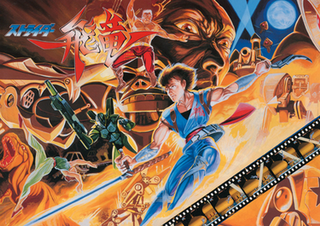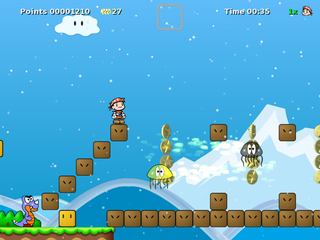
A player character is a fictional character in a video game or tabletop role-playing game whose actions are controlled by a player rather than the rules of the game. The characters that are not controlled by a player are called non-player characters (NPCs). The actions of non-player characters are typically handled by the game itself in video games, or according to rules followed by a gamemaster refereeing tabletop role-playing games. The player character functions as a fictional, alternate body for the player controlling the character.
An action game is a video game genre that emphasizes physical challenges, including hand–eye coordination and reaction time. The genre includes a large variety of sub-genres, such as fighting games, beat 'em ups, shooter games, rhythm games and platform games. Multiplayer online battle arena and some real-time strategy games are also considered action games.

Onimusha is a series of video games developed and published by Capcom. It makes use of the historic figures that shaped Japan's history, retelling their stories with supernatural elements. Most of the games are of the action-adventure genre, a combination of third-person hack-and-slash combat and puzzle elements. The player protagonist wields the power of the Oni, enabling them to fight the Genma, the main enemy in the series. As of June 2023, the series has sold a total of 8.6 million copies worldwide, making it Capcom's ninth best-selling franchise, behind Resident Evil, Monster Hunter, Street Fighter, Mega Man, Devil May Cry, Dead Rising, Ace Attorney, and Marvel vs. Capcom.

Strider, released in Japan as Strider Hiryū, is a hack-and-slash platform game released in arcades in 1989 by Capcom. Set in a dystopian future where Earth is ruled by the tyrannical Grandmaster Meio, it follows the titular Strider named Hiryu as he attempts to end his tyrannical reign for good. The game resulted from cooperation between Capcom and manga publisher Moto Kikaku. It marked the video game debut of Strider Hiryu, after the character was introduced in the 1988 manga Strider Hiryu.
The following article is a broad timeline of arcade video games.

Dungeons & Dragons: Shadow over Mystara is an arcade game developed and published by Capcom in 1996 as a sequel to Dungeons & Dragons: Tower of Doom. The game is set in the Dungeons & Dragons campaign setting of Mystara.

Dungeons & Dragons: Tower of Doom, published in 1994, is the first of two arcade games created by Capcom based on the Dungeons & Dragons tabletop role-playing game and set in the Mystara campaign setting. It is a side scrolling beat 'em up with some role-playing video game elements for one to four players. The game was also released on the Sega Saturn, packaged with its sequel, Dungeons & Dragons: Shadow over Mystara, under the title Dungeons & Dragons Collection, although the Saturn version limited the gameplay to only two players. In 2013, both games were re-released for modern platforms as Dungeons & Dragons: Chronicles of Mystara.
A beat 'em up is a video game genre featuring hand-to-hand combat against a large number of opponents. Traditional beat 'em ups take place in scrolling, two-dimensional (2D) levels, while a number of modern games feature more open three-dimensional (3D) environments with yet larger numbers of enemies. The gameplay tends to follow arcade genre conventions, such as being simple to learn but difficult to master, and the combat system tends to be more highly developed than other side-scrolling action games. Two-player cooperative gameplay and multiple player characters are also hallmarks of the genre. Most of these games take place in urban settings and feature crime-fighting and revenge-based plots, though some games may employ historical, science fiction or fantasy themes.

Knights of the Round is an arcade game released by Capcom in 1991. A side-scrolling beat 'em up based loosely on the legend of King Arthur and the Knights of the Round Table, the game features an action role-playing video game-like level advancement system, with fighters automatically being upgraded to new weapons and armor as they advance through the game. In September 13, 2018, Capcom announced Capcom Beat 'Em Up Bundle with the arcade edition of Knights of the Round being one of seven titles and being released digitally for Nintendo Switch, PlayStation 4, Xbox One, and Windows on September 18, 2018.

Magic Sword, fully titled as Magic Sword: Heroic Fantasy, is a side-scrolling fantasy hack-and-slash game released by Capcom for arcades in 1990. The game casts the player as a hero who must fight his way through a mystical tower in order to save the world. The player can use a sword, axe or magic, and can also rescue and recruit potential allies of various character classes, each of which has its own special abilities. Three years earlier, Capcom had released the similar Black Tiger.

A side-scrolling video game is a game viewed from a side-view camera angle where the screen follows the player as they move left or right. The jump from single-screen or flip-screen graphics to scrolling graphics during the golden age of arcade games was a pivotal leap in game design, comparable to the move to 3D graphics during the fifth generation.

Onimusha: Warlords, known in Japan as Onimusha, is an action-adventure hack and slash video game developed and published by Capcom for the PlayStation 2. The first entry of the Onimusha series, it was originally released in 2001. An updated form as Genma Onimusha for the Xbox was released in 2002. The original Warlords version was ported to Microsoft Windows, although it was only available in China and Russia. A remaster for Nintendo Switch, PlayStation 4, and Xbox One was released in 2018, with a Windows version following in 2019.
Hideki Kamiya is a Japanese video game designer and director. He began his career in 1994 with Capcom, where he directed Resident Evil 2 (1998), Devil May Cry (2001), Viewtiful Joe (2003), and Ōkami (2006). From 2004 to 2006, he worked for the Capcom subsidiary Clover Studio.
Devil May Cry is an action-adventure game franchise created by Hideki Kamiya. It is primarily developed and published by Capcom. The series centers on the demon hunter Dante and his efforts to thwart various demon invasions of Earth. Its gameplay consists of combat scenes in which the player must attempt to extend long chains of attacks, avoiding damage and exhibiting stylized combat by varying their attacks; this combat, along with time and the number of items collected and used, are considered in grading the player's performance. Across the series, new characters with unique skills are available.

Devil May Cry is a 2001 action-adventure game developed and published by Capcom. Released from August to December, originally for the PlayStation 2, it is the first installment in the Devil May Cry series. Set in modern times on the fictional Mallet Island, the story centers on Dante, a demon hunter who uses his business to carry out a lifelong vendetta against all demons. He meets a woman named Trish who takes him on a journey to defeat the demon lord Mundus, who is responsible for the deaths of Dante's brother and mother. The story is told primarily through a mixture of cutscenes, which use the game engine and several pre-rendered full motion videos. The game is very loosely based on the Italian poem Divine Comedy by the use of allusions, including the game's protagonist Dante and other characters like Trish and Vergil (Virgil).
Soundelux Design Music Group is an American sound studio located in Hollywood, California.

Rastan Saga, known as Rastan in North America, is a side-scrolling hack and slash arcade video game released by Taito in 1987. It was a critical and commercial success and was ported to home platforms.

Bayonetta is a series of hack and slash action-adventure games created by Hideki Kamiya, developed by PlatinumGames, and owned by Sega. The franchise was introduced in 2009 with Bayonetta. Two sequels were released, Bayonetta 2 (2014) and Bayonetta 3 (2022), as well as a spinoff, Bayonetta Origins: Cereza and the Lost Demon (2023). In the games, players control a witch nicknamed Bayonetta as she wields dual pistols, shooters in her high heels, and long, magically transforming hair which becomes a deadly weapon.











